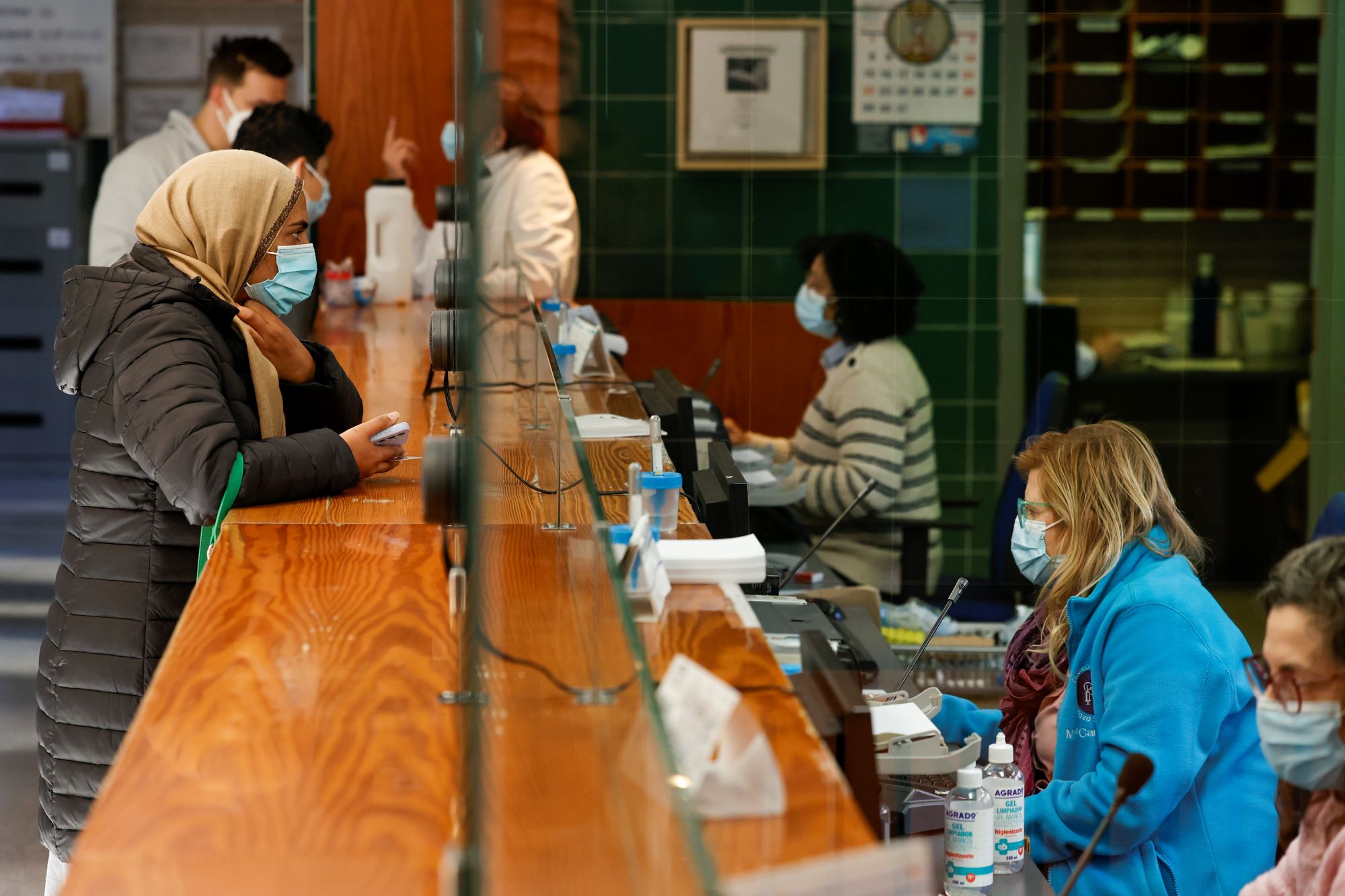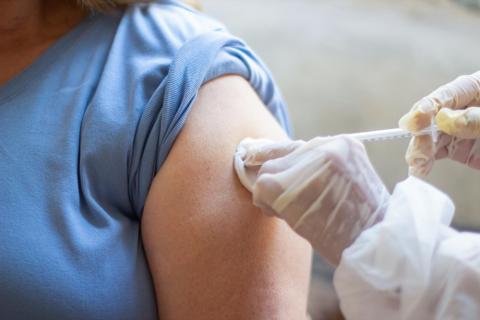Reactions: flu epidemic may have peaked, according to latest SiVIRA report
The influenza epidemic could have reached its peak of activity in Primary Care in the last week of 2023, while hospitalization due to influenza continues to rise, according to the latest weekly SiVIRA report published by the Instituto de Salud Carlos III. Thus, during the first week of 2024 there has been a decrease in the primary care rate for influenza: 387 cases per 100,000 inhabitants compared to 430 cases the previous week. This is the first decrease in incidence in four weeks.

General view of workers and users of a health center in the Valencian Community. EFE/Biel Aliño.
Inmaculada Casas - gripe SiVIRA
Inmaculada Casas
Head of the Respiratory Virus and Influenza Research Group of the Carlos III Health Institute
Respiratory viruses circulating during an epidemic season of respiratory infection allow us to know the dynamics of most acute respiratory infections that in some cases cause hospitalization due to their severity.
Viral detection is performed by genetic analysis systems of one or several viruses simultaneously (RT-PCR), which are increasingly sensitive, influencing the reduction and elimination of unnecessary antibiotic treatments or the implementation of a specific antiviral treatment and its duration.
The analysis of influenza, SARS-CoV-2 and Respiratory Syncytial Virus simultaneously in the laboratories of the different Autonomous Communities generates a specific knowledge of the circulation of each one of them, being the positivity rates to these three viruses one of the markers of the evolution of acute respiratory infections in each of the epidemic seasons.
Apart from the positivity rates, knowledge of the biological and genetic characteristics of the circulating viruses adds to the surveillance system basic information for decision making affecting the control of respiratory infection in the population.
After the 2020 pandemic, SARS-CoV-2 was included in influenza surveillance, extending such surveillance to acute respiratory infection and, as another respiratory virus, its molecular characterization allows us to associate the appearance and circulation of certain lineages, currently the omicron variant, to infection rates in both sentinel and non-sentinel surveillance analyses.
In addition, influenza viruses undergo genetic and antigenic changes, and we can say that sentinel genomic virological surveillance systems have been strengthened in the wake of the covid-19 pandemic.
This season, influenza A/H1N1 viruses are dominant and mostly similar to the A/H1 vaccine component. However, when analyzing the circulating A/H3N2 viruses, which are in the minority, it is observed that they belong to a different genetic group from the group of the vaccine virus in its A/H3 component. Antigenic studies are currently underway.
The integration of the three respiratory viruses through the detection of the new SARS-CoV-2 lineages, the sequencing of influenza in a systematic way with the characterization of its 8 segments of both influenza A and B, and finally the characterization of the possible escape of Respiratory Syncytial Virus to monoclonal antibodies used this season as immunoprophylaxis (Nirsevimab) for the prevention of bronchiolitis, are the main virological novelties presented in the current epidemic season.
Participa en la elaboración del informe SiVIRA.
Amparo Larrauri - gripe EN
Amparo Larrauri
Head of the Influenza and other Respiratory Virus Surveillance Group of the National Epidemiology Centre.
The emergence of covid-19 caused a change in the seasonal behavior of respiratory viruses that led to a change in the approach of historical influenza surveillance systems, to become comprehensive surveillance systems for respiratory pathogens. In Spain, following the recommendations of the European Centre for Disease Control (ECDC) and the World Health Organization (WHO), the implementation of the Acute Respiratory Infection Surveillance System (SiVIRA) was initiated in October 2020. SiVIRA consists of the sentinel surveillance system for mild acute respiratory infection (ARI) in primary care and the surveillance system for severe acute respiratory infection (SARI) in hospitals. The surveillance of ARIs and SARI arose from the adaptation and previous experience of the Influenza Surveillance System in Spain (SVGE) and aims to lay the foundations of a stable comprehensive respiratory surveillance, with the will to last over time, which will allow surveillance of several respiratory pathogens and any other respiratory virus that may emerge in the future.
The objective of SiVIRA is to monitor the evolution of acute respiratory infections in Primary Care and hospitals, identifying unexpected patterns that may serve as a warning signal, as well as to monitor epidemics of influenza, covid-19 and respiratory syncytial virus (RSV) infection. Surveillance of ARIs or ARRIs starts with the capture through the health system of "clinical syndromes" that respond to an acute respiratory infection of any etiology and the systematic selection of a sample of ARI or ARRI patients for the triple microbiological diagnosis of influenza, SARS-CoV-2 and RSV. The system can describe the epidemiological and microbiological characteristics of these respiratory agents, as well as contribute to the evaluation of the effectiveness of control and prevention measures, especially vaccines.
Each SiVIRA surveillance season covers a full year, from October of one year to September of the following year. With the exception of the first 2020-21 season, in which the circulation of SARS-CoV-2 almost completely displaced the rest of the respiratory viruses, in the rest up to the current 2023-24 season, the three viruses that SiVIRA monitors in a more specific way have circulated, in addition to other respiratory viruses: influenza, SARS-CoV-2 and respiratory syncytial virus (RSV). The temporal presentation of these three viruses has been different for each of them and also in each season, giving rise to different epidemic waves of influenza, covid-19 and RSV infection for which SiVIRA has provided timely information on their evolution and epidemiological and virological characteristics in space and time.
In the 2023-24 season, we find simultaneous circulation of influenza, SARS-COV-2 and RSV, a typical situation for this winter season, with the difference that since 2020 SARS-CoV-2 joins as a travel companion to the respiratory virus season. However, the particularity of the last four weeks is that influenza has shown a greater intensity of circulation than the other two viruses, giving rise to a steep upward slope in the incidence of influenza in Primary Care, which decreases for the first time in the first week of January 2024.
This change in trend could signal that the peak of influenza activity in the last week of 2023 has been exceeded and, if surveillance data confirm this in the coming week, will begin to decline progressively thereafter. Comparison of these influenza incidences with historical influenza series before the covid-19 pandemic requires complex analysis, taking into account the change in surveillance systems before and after the covid-19 emergency. When appropriate analytical adjustments are made, we see that, at the peak of activity this season, influenza has reached a high level of transmissibility, albeit in the upper range of pre- and post-pandemic influenza epidemics. A situation not extraordinary that we have seen in historical flu seasons such as 2014-15.
The high transmissibility of influenza in the community is undoubtedly influencing the fact that hospitalization due to influenza continues to rise, especially in people over 60 years of age, although so far no parameters have been observed that indicate greater severity than in previous seasons. Nevertheless, SiVIRA must maintain timely and accurate surveillance as it has done up to now, to identify any factors that may be associated with situations of complications of influenza infection or other respiratory viruses.
Hospitalization due to covid-19 is at lower levels than in the two previous seasons, which speaks, in addition to a level of natural immunity due to previous infections, of the success of the national covid-19 vaccination program since its inception. Also in the case of hospitalization due to RSV infection, hospital morbidity is lower than in previous seasons, which may be influenced both by the immunity acquired by the intense epidemic of bronchiolitis in children last season, and by the impact of immunization with the monoclonal antibody Nirsevimab, which has been administered for the first time this season in children under six months of age, for the prevention of hospitalization due to RSV infection.
In the current situation of high circulation of respiratory viruses in the community, it is very convenient to maintain personal respiratory hygiene measures to try to reduce transmission at the population level. And it is very important to administer the influenza vaccine and covid-19 to all the recommended vaccination groups that have not yet received the vaccine this season.
Conflict of interest: participates in the preparation of the SiVIRA report.



